Submitted by Berrin Chatzi Chousein
Exclusive: Walls, "the ugliest version of racism and exclusionary citizenship" says Fonna Forman
United States Architecture News - Oct 11, 2017 - 11:50 17723 views
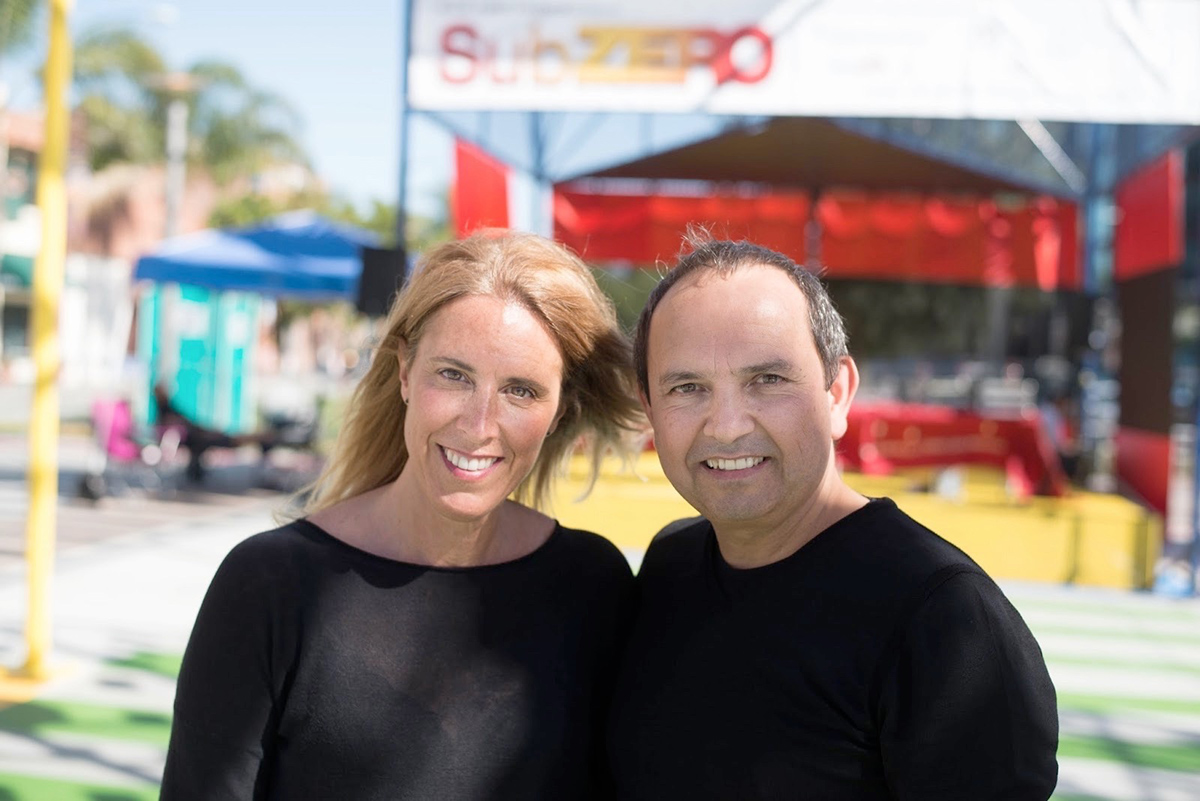
New urban strategies should look at the dynamics of small scale-neighborhoods, their structural alterations and their new ways of constructing patterns, which impose new political and economic policies; American political theorist Fonna Forman told in an exclusive interview with World Architecture Community within the scope of this year's reSITE Conference in Prague.
Forman stated that "the best, and most equitable, way to encourage density in a city, is not through 'new urbanist' strategies and form-based code that displace or hinder emergent dynamics, but through imaginative urban policy that supports small-scale adaptation, retrofit and neighborhood-led development."
Fonna Forman is a Professor of Political Theory and Founding Director of the Center on Global Justice at the University of California, San Diego. Forman is the co-director of Estudio Teddy Cruz + Fonna Forman with her partner, American architect and urbanist Teddy Cruz. Their studio Estudio Teddy Cruz + Fonna Forman serves as a research-based political and architectural practice in San Diego, specifically known with their investigations on urban conflict and "informal architecture" for rethinking public policy and civic infrastructure, with a special emphasis on Latin American cities.
reSITE's small talk with Teddy Cruz, published within the scope of this year's conference. Video by reSITE.
Teddy Cruz and Fonna Forman were among the speakers to give a keynote address referring to the theme of reSITE, titled as "In/visible City". Teddy Cruz made an impressive presentation about "border walls" tackling the problems of infrastructure and local communities in a wider scale. Although Forman couldn't attend the conference, Teddy Cruz's stunning presentation showed in detail how their studio evaluates the positive aspects of the immigration conditions seen in every city.
Responding to World Architecture Community editor-in-chief, Berrin Chatzi Chousein's questions, Fonna Forman introduces her strategical approaches on "informal settlements" as a new interface that tries to keep the balance between "top-down (institutional) and bottom-up (community-based) resources and knowledge", by adding that "they hold institutions accountable during this process not only for increasing investments in social service and public infrastructure, but for recognizing the ingenuity of bottom-up practices and integrating them into more equitable and inclusive urban policy."
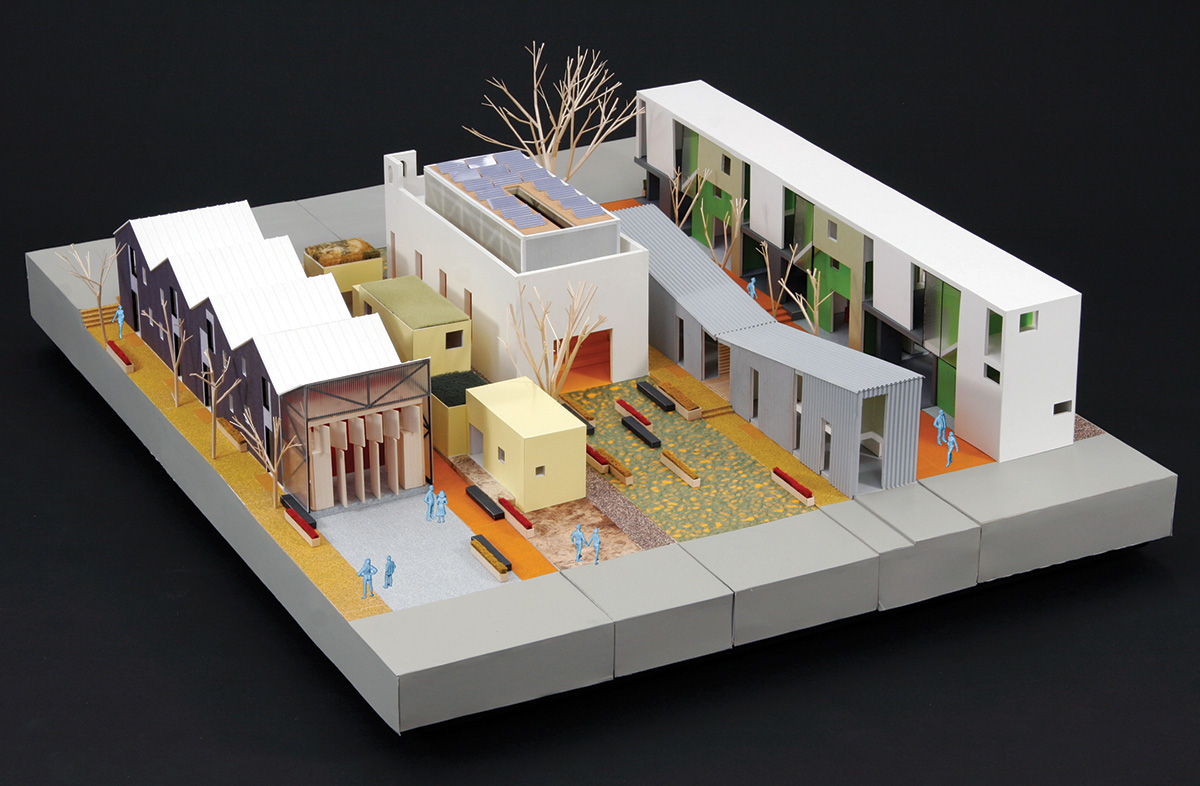
'Living Rooms' project at the Border is an affordable-housing project, in collaboration with Casa Familiar in the border neighborhood of San Ysidro in San Diego, California. Estudio Teddy Cruz + Fonna Forman embedded diverse housing types and economies in an infrastructure of socioeconomic and cultural programming. Image © Estudio Teddy Cruz + Fonna Forman
Aiming to dissolve the boundaries between theory and practice, the studio has been working on large-scale alternative economy models and healthy urbanisation strategies, examining the living patterns of informal small-scale communities between San Diego and Tijuana for years.
But, their research, detailed mapping and documentation on San Diego–Tijuana border should not only be considered as only one concrete example or experimental case that pushes the boundaries of illegal placements or displacements. Teddy Cruz and Fonna Forman's study model, indeed, wants to be a new "driving force" or alternative model on a wider scale to make the right decision and to inject right urban policies.
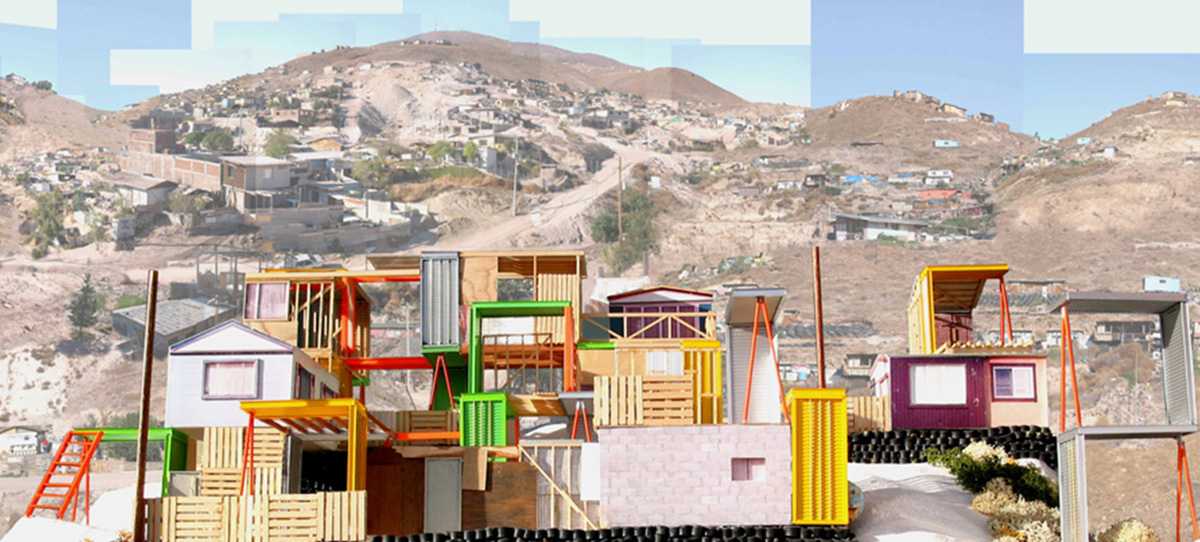
"Manufactured Sites" by Estudio Teddy Cruz + Fonna Forman. The project developed as an "informal architecture" proposing the reuse of materials discarded from manufacturing plants and repurposed to create low-cost affordable housing for the underpaid employees. Image © Estudio Teddy Cruz + Fonna Forman
In the below transcript of the interview, Fonna Forman also discusses the irreversible damage of building physical border walls across the globe. Building physical walls can be seen as "the ugliest version of racism and exclusion of citizenship," according to political scientist Fonna Forman.
"In the context of isolationist dynamics across the globe today, physical border walls serve not only as barriers against 'invasion', but mark an era of 'patriotic' withdrawal from international cooperation in a futile attempt to recover an 'alien-less' sovereignty," she told World Architecture Community.
"Building walls is the physicalization of mistrust - typically by a powerful and rich country against a vulnerable one," she added. "It is the most overt evidence that there is little faith in social, economic or political solutions to conflict among people."
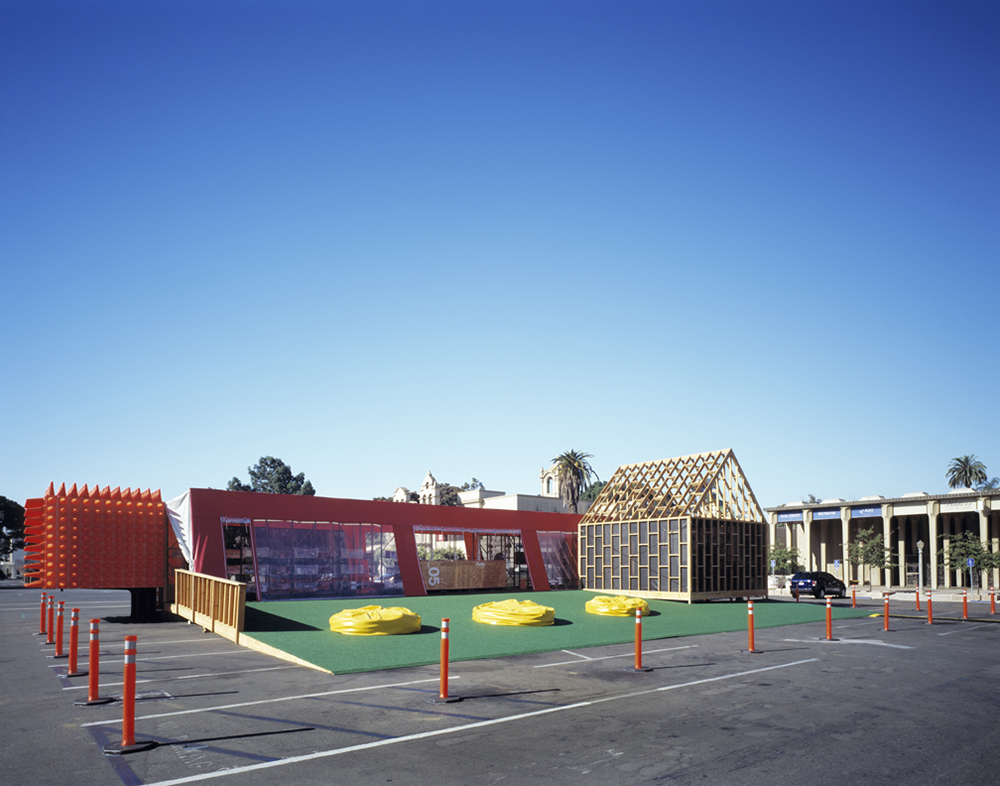
InfoSite was a nomadic public space and cultural reference library built for the Cross-Border arts project inSite 05. Image courtesy of Estudio Teddy Cruz + Fonna Forman
Read the full transcript of our interview with Fonna Forman below:
Berrin Chatzi Chousein: Your research focuses on political theory, urban conflicts, human rights and transforming these conflicts into a progressive transnational urbanism to open up new design processes and urban policies. If we think about the basic/infrastructural needs of local communities in many parts of the cities, to transform their environments with local citizens or volunteers and other participants; do you consider there are still some major inadequacies to convert their local architecture (beyond providing a shelter) into a better place? I mean liveable, healthy, rich, sustainable, comfortable... I’m actually asking where does the local community stand in the 21st Century urbanism in relation to bottom-up urban design processes?
Fonna Forman: Our practice is located in a zone of global conflict and poverty that divides two cities, two countries, two continents, and two hemispheres. The border cities of San Diego and Tijuana together comprise the largest binational metropolitan region in the world. The region has been paradigmatic of the dynamics of uneven urban growth across the world in the past few decades – an urban asymmetry that is dramatized in this region by the close proximity of wealth and poverty, as some of the poorest, most marginalized informal settlements in Latin America sit just minutes away from San Diego’s mega-wealthy suburbs, some of the richest zip-codes in the world. This border region is a microcosm of the conflicts and deprivations that globalization has inflicted on the world’s most vulnerable people.
Teddy and I have been documenting and developing theories of informality to communicate the ingenuity of people living in conditions of scarcity in the world’s exploding urban peripheries. But of course, there are major deficits in housing, social service and public infrastructure in Tijuana that cannot be addressed through the bottom-up tactics that we investigate. In many areas, even the minima of human shelter, food and clean water are not guaranteed. Unlike those who might want to emphasize small-scale urban informality to demonstrate self-sufficiency, and to let formal institutions off the hook, our intention is quite the opposite. For us, top-down and bottom-up need to meet
When it comes to social welfare and justice in the city! In fact, much of our research explores the way exemplary municipalities like Medellín, Colombia, have committed to co-producing the city with communities, reinventing municipal governance, urban development and public spending by redirecting urban surplus to supporting and increasing the capacity of bottom-up processes. In our practice, we are always seeking new interfaces between top-down (institutional) and bottom-up (community-based) resources and knowledges, holding institutions accountable not only for increasing investments in social service and public infrastructure, but for recognizing the ingenuity of bottom-up practices and integrating them into more equitable and inclusive urban policy.

Estudio Teddy Cruz, Neighborhood Urbanism: The Informal as a Tool to Transform Policy, 2008. Image courtesy of The Avery Review, Teddy Cruz and Fonna Forman, 'Unwailing Citizenship', 'Unwailing Citizenship'.
Berrin Chatzi Chousein: You also direct Estudio Teddy Cruz + Fonna Forman in which you transform the knowledge into new liveable spaces as you call them "informal architecture" developed for the cities’ borders so that they can grow and develop in better ways. Could you talk about some of the practical interventions you developed within the scope of the studio converting the local knowledge into reality? What are the basic design tools or strategies that you apply (concrete agenda) to really contribute for the physical infrastructure and the public culture to find or defend its own identity?
Fonna Forman: While much of our research has focused on social and economic disparities in the border region, we are equally interested in contrasting urban development patterns in San Diego and Tijuana over time. While the cities have relatively equal populations, San Diego has sprawled to nearly six times the size of Tijauna over the last half-century. The conventional planning solution to sprawl in cities today, including San Diego, is to refocus on urban infill in pursuit of to 'livability', 'walkability,' and so forth. But too often, and San Diego is no exception, this leads to gentrification, the importation of consumption-cultures, ethnic theming, and the white-washing of communities and displacement of their local cultures and economies.
Teddy and I have witnessed how the consolidation of political and economic power, manifested in exclusionary, developer-driven urban policy, in the San Diego–Tijuana border region have provoked small border neighborhoods to adapt by transforming their own spaces into more socially and economically sustainable environments in the absence of formal permits and government support.
We have also long been interested in informal urban development in Tijuana, and have been tracking how communities in the peripheral settlements of Tijuana, in conditions of scarcity, build housing from the waste and urban debris of San Diego. Likewise, in border neighborhoods, like San Ysidro, California, immigrant communities navigating conditions of scarcity have carried their ingenious urban tactics with them as they retrofit their adoptive neighborhoods from the bottom-up, to accommodate cultural and economic living patterns.
In this way, these communities have discovered how to informally transgress imposed political and economic forces. We have been investigating how these practices of local cultural and economic production operating outside of formal institutions—can help us formulate alternative economies of development and urbanisation. We believe that cities like San Diego have a lot to learn from informal and incremental development patterns in cities like Tijuana, and in immigrant border neighbourhoods. We have argued that the best, and most equitable, way to encourage density in a city is not through 'new urbanist' strategies and form-based code that displace or hinder emergent dynamics, but through imaginative urban policy that supports small- scale adaptation, retrofit and neighborhood-led development.
Berrin Chatzi Chousein: You worked on Tijuana-San Diego border region for many years and it turned into "a knowledge laboratory" to move forward and you developed some affordable housing prototypes for this region. If we go back to my previous term "informal architecture", how exactly would you define "informal architecture"? If we attribute some sort of physical meanings to it, like solving only basic needs, what position should one take around social continuity, while avoiding separating the communities from one another? Is that even possible?
Fonna Forman: Informal urban phenomena – emergent, non-conforming alterations of the city by people navigating conditions of scarcity - have exploded in the last two decades of increasing global wealth, with the rapid urbanization of the world’s population and the proliferation of slums on the peripheries of global cities everywhere. For us, these bottom-up, informal practices are not only about basic need subsistence. For us, they are far more significant: they point to other ways of constructing the city and of constructing citizenship.
While our research has carefully documented emergent, informal, "bottom-up" forms of urbanization, the ultimate goal of our work in San Diego–Tijuana and other cities is to seek ways by which this bottom-up, informal knowledge can reach the right decision-makers to transform urban policy. All our public space and housing interventions are community–based and committed to activating bottom-up sensibilities, situating housing in an infrastructure of public space, plugged with social and cultural activity. They have taken a long time to build because we often find ourselves pushing hard against existing zoning and urban policy that would prohibit them.
Our two affordable housing projects in San Ysdiro, for example - Living Rooms at the Border and Abuelitos (Senior housing with Childcare) are models of what small scale, incremental, mixed-use, community-led housing can look like. The projects, a long-term partnership with the San Ysidro-based non-profit Casa Familiar have been in development for a very long time, negotiating unfavorable zoning, policy, the varying availability of state redevelopment funding, and so on. Now, with the generous support of ArtPlace America and the PARC Foundation, we are in permitting, and hope to break ground on Living Rooms within the next 12 months. Driven by the same commitments to incremental development and funding, we are also currently working with a consortium of non-profits in Tijuana to develop a series of public spaces, structural frameworks for housing, and green interventions in an informal settlement adjacent to the border wall.
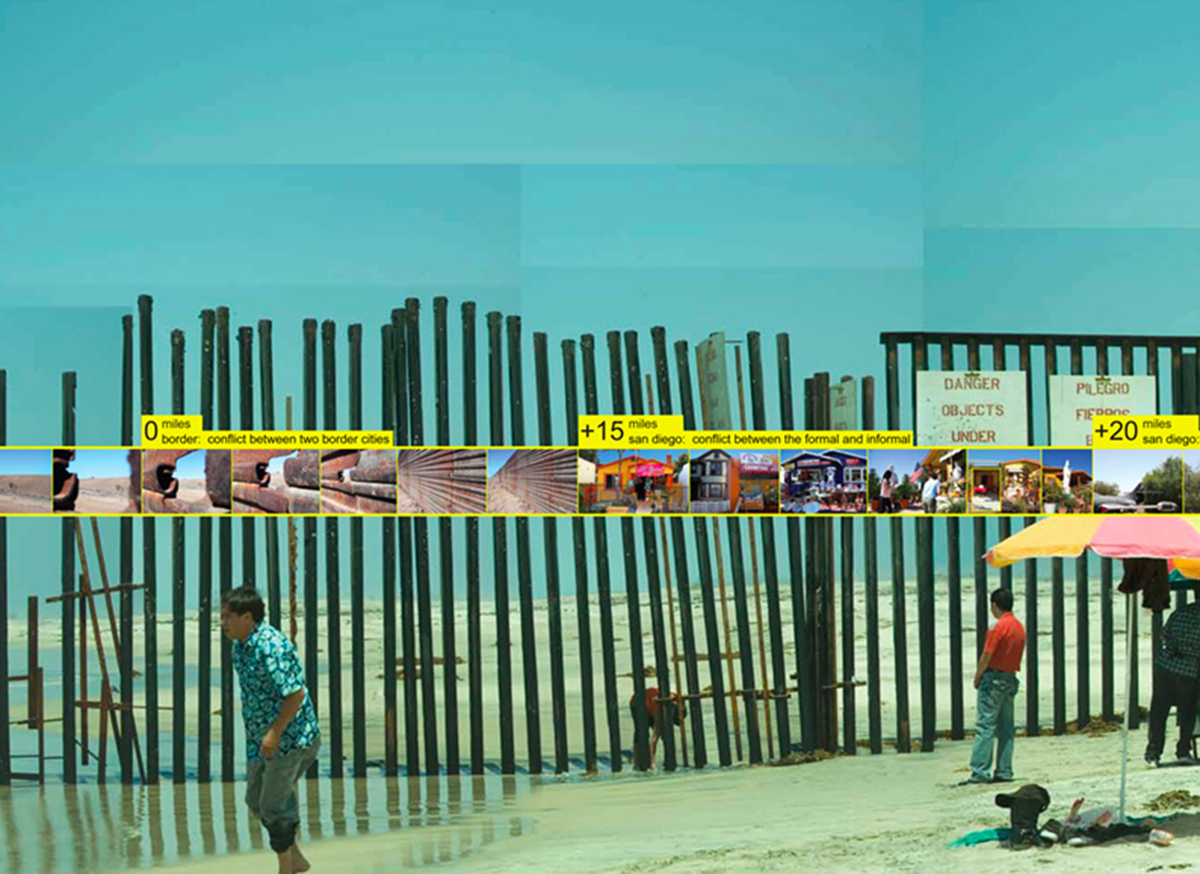
Estudio Teddu Cruz, Radicalizing the Local: Sixty Linear Miles of Transborder Conflict, 2008. Image courtesy of The Avery Review, Teddy Cruz and Fonna Forman, 'Unwailing Citizenship', 'Unwailing Citizenship'.
Berrin Chatzi Chousein: If we turn back to today’s discussion, in the current political climate with Trump, how would you evaluate the US-Mexico border in the context of your work?
Fonna Forman: In the context of isolationist dynamics across the globe today, physical border walls serve not only as barriers against 'invasion,' but mark an era of 'patriotic' withdrawal from international cooperation in a futile attempt to recover an 'alien-less' sovereignty. Rejecting an ethical responsibility to co-exist with others, and to demonstrate care for the most vulnerable, these shifts criminalize and traumatize immigrants across the world, and validate the ugliest version of racism and exclusionary citizenship that we have witnessed in decades.
Building walls is the physicalization of mistrust - typically by a powerful and rich country against a vulnerable one. It is the most overt evidence that there is little faith in social, economic or political solutions to conflict among people. And it is to most overt symbol of social neglect and degradation. In our work we have been seeking new ways of understanding the ethical, social and cultural flows that move back and forth across border regions - things that walls cannot prevent. These flows were as real under communism in Eastern Europe as they are for us now in the San Diego-Tijuana region. The highest ethical end of human life is to find ways to co-exist and even live well together, despite our differences. Modernity’s promise that we would move closer and closer to a world of peace and prosperity. Walls are a sign that we have surrendered to fear and mistrust.
In our practice, we have been exploring creative ways to transgress the wall, and to recognize the many interdependencies and flows - environmental, economic, cultural - that move back and forth regardless of the arbitrary physical and jurisdictional barrier that separates us. We are not interested in decorating the wall, or making it aesthetically more pleasing. We are interested in making it more humane, more environmentally just, smarter and more porous, so that it doesn’t wreak havoc on the vulnerable neighborhoods that flank it, the delicate environmental ecologies that surround it, and the daily lives of ordinary people who are forced by economic necessity to cross the border everyday.
100,000 people cross the border between San Diego and Tijuana everyday, making it the most trafficked border checkpoint in the world. Long border-wait times, caused by the hardening of the wall and the dramatic increase of surveillance since 9-11, means many people spend a significant portion of their lives idling in cars, spewing CO2 into the air. Regional air quality is atrocious, making life in precarious border communities on both sides of the border disproportionately vulnerable to respiratory disease.
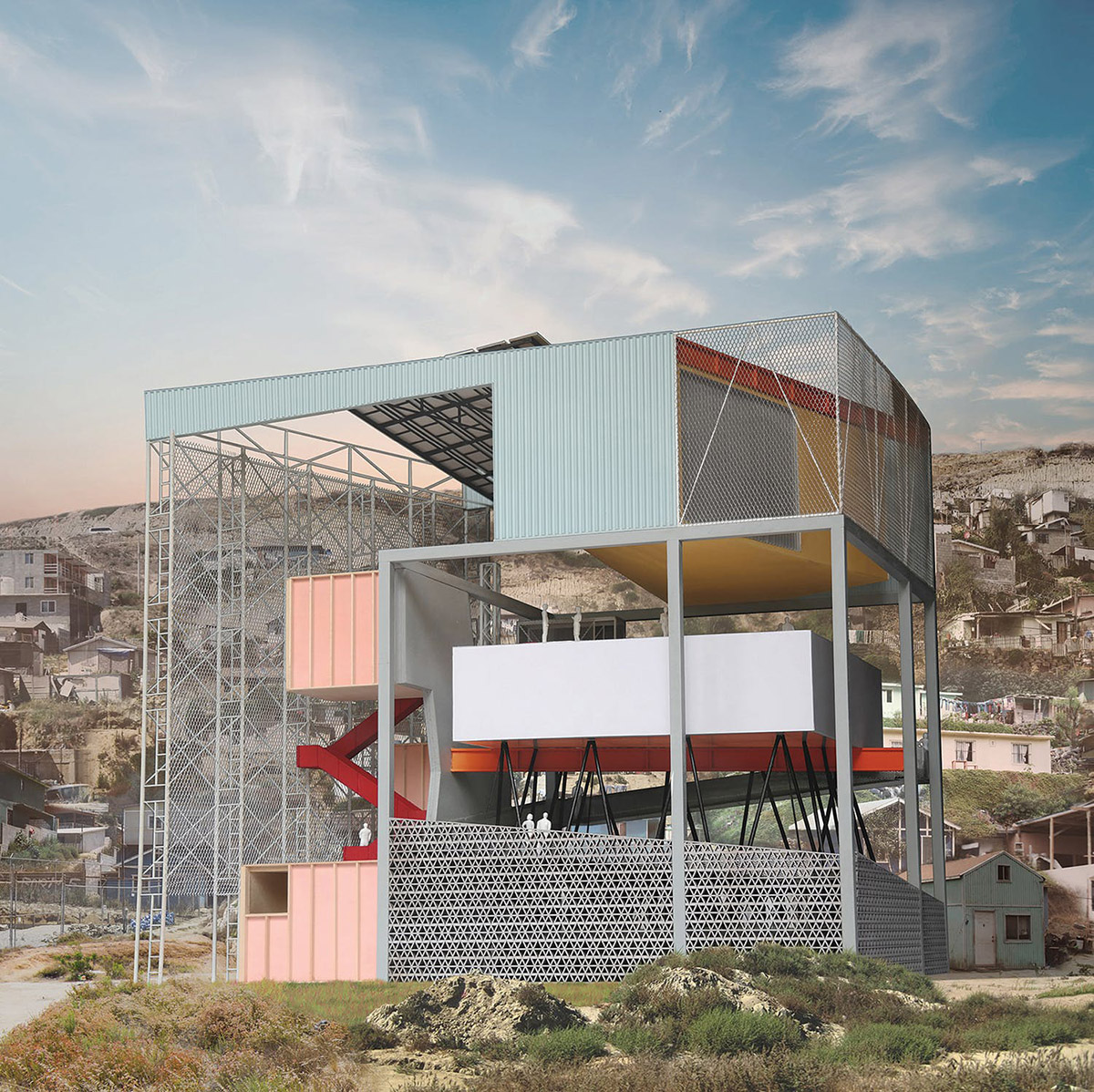
UCSD Cross-Border Community Station: A Public Space that Educates, Estudio Teddy Cruz + Forman. The project will be exhibited at the U.S. Pavilion, titled 'Dimensions of Citizenship', Venice Architecture Biennale 2018. Image © Estudio Teddy Cruz + Fonna Forman
Berrin Chatzi Chousein: In the meantime, the government launched a latent competition, with only five days for submissions, and which received many entries. Beyond the physical disruption or fragmentation this will create on both sides, how would you evaluate architects’ involvement to this particular political gambit? As architects, where will we draw the line with regards to the built affirmation of the social, political, and economic status quo?
Fonna Forman: Regarding the wall, Teddy and I have argued that "neutrality is complicity." When the Third Mind Foundation, during the last US election cycle, announced an international competition to design a new border wall between the United States and Mexico, inspired by Donald Trump’s campaign promise to build a continental border wall, we were alarmed. We refused to serve on the jury.
Their brief began with an emphatic statement "Let us be clear, we take no position on this issue, we remain politically neutral." A year later, this cultural exercise in "political neutrality" manifested in an actual "federal business opportunity" in an RFP issued by the Trump Administration for a "design-build structure" to span the southern border of the United States.
Sadly many architects, urbanists and engineers got onboard – including several firms in San Diego. For us, responding to Trump’s wall with a serious discussion of material choice, construction techniques, and maintenance, or to think about the potential economic opportunities that a more "creative and beautiful" wall can open up, is to hide complicity under a pretense of neutrality, and to capitulate to a world fundamentally shaped by power and capital and increasingly defined by social and economic injustice. Beautifying the wall naturalizes and legitimizes it, makes it less intolerable, and relieves public guilt. What we need instead is a change in our public vision. We have argued that architects to take a stand, and decide where and when not to build.
(-end of transcript)
Fonna Forman is a professor of Political Theory and Founding Director of the Center on Global Justice at the University of California, San Diego. A theorist of ethics and public culture, her work focuses on human rights at the urban scale, climate justice in cities, border ethics, and equitable urbanization in the global south. She is best known revisionist research on Adam Smith, recuperating the ethical, social, spatial and public dimensions of his thought.
She is also the Vice-Chair of the University of California Climate Solutions Group, and on the Global Citizenship Commission (advising UN policy on human rights).
Fonna Forman, with her partner Teddy Cruz, documents these local constructive/deconstructive settlements and gives a clear insight over their sincere stories and economies in one of their latest books titled "Informal Market Worlds: Reader: The Architecture of Economic Pressure", published by nai010 publishers in 2015.
Cruz & Forman are principals in Estudio Teddy Cruz + Fonna Forman, a research-based political and architectural practice investigating issues of informal urbanization, civic infrastructure and public culture, with a special emphasis on Latin American cities. Blurring conventional boundaries between theory and practice, and transgressing the fields of architecture and urbanism, political theory and urban policy, visual arts and public culture, Cruz + Forman lead variety of urban research agendas and civic/public interventions in the San Diego-Tijuana border region and beyond.
From 2012–13 they served as special advisors on civic and urban initiatives for the City of San Diego and led the development of its Civic Innovation Lab. Together they founded the UCSD Cross-Border Initiative, a platform for engaged research and teaching on poverty and social equity in the border region. The research and practice have been profiled widely in important publications and exhibitions around the world. Their work has been funded by the Ford Foundation, the Andrew W. Mellon Foundation, ArtPlace America, the PARC Foundation, the San Diego Foundation, and the Surdna Foundation, among others.
World Architecture Community is media partner for this year's reSITE and World Architecture Community broadcasted a number of keynote addresses and sessions throughout the event.
Top image: Fonna Forman and Teddy Cruz. Image © Estudio Teddy Cruz + Forman
